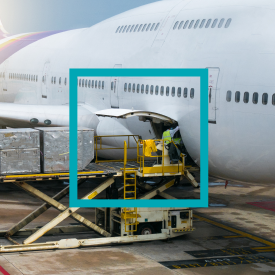- blog
- How to Make Data Driven Customer Experience Improvements in Airports
How to Make Data-Driven Customer Experience Improvements in Airports
.png?width=600&height=600&name=Square%20-%20Data-driven%20improvements%20(600x600).png)
A passenger’s airport experience encompasses much more than their time in the air or even waiting to board their flight. The efficiency and ease of check-in, security, dining, and more all affect how they feel about air travel.
If passengers spend too long in a security line, they may be irritable and uninterested in pre-flight purchases. If they can’t find the right check-in counter, they may form a poor impression of a certain airline brand before ever speaking with a team member or boarding a flight.
The airport industry is focusing on the entire airport journey, thinking of people in the airport as customers rather than just airline passengers. That way, every employee — from flight attendants to retail staff — can work toward a common goal: delivering a seamless customer experience.
Airport operators are leveraging business intelligence (BI) solutions to unify customer journeys and enable better collaboration between retailers, airlines, security teams, and more.
In this blog, we’ll discuss why many airports are taking a data-driven approach to their operations and how they’re using BI to support passengers from the moment they set foot in the airport to when they reach their final destination.
At Security Checkpoints
Security lines are a familiar airport pain point for travelers worldwide. Spikes in air traffic, busy holiday weekends, and staffing shortages at airports all contribute to delays at security checkpoints. Customers may arrive at the airport several hours early in anticipation of extended wait times, but even the standard “two-hour rule” may not be enough to keep them on schedule during busy days.
As the airline industry bounces back from the pandemic, airports must move passengers through security lines quickly and painlessly by keeping staff informed and staying ahead of potential delays.
Data-driven forecasting can help security operators take a proactive approach to staffing and operational planning. Rather than troubleshooting the cause of a delay after the line backs up, operators should leverage BI and analytics tools to forecast passenger volumes and staff each security checkpoint accordingly.
Forecasting helps operators identify trends in passenger volumes, as well as common causes of security delays — from staffing shortages to the instructions passengers ignore most often. With these insights in hand, leadership teams can measure success against department-level key performance indicators and get ahead of delays by hiring more employees or improving signage for passengers.
ALSO READ: How BI can help you reduce wait times, improve planning, and forecast better.
Along with proactive forecasting, security teams can use analytics to identify and resolve delays in real time. Management teams can use BI dashboards to monitor activities across every security checkpoint. If an employee needs backup or a problem arises, managers can instantly deploy the necessary resources to support them without having to make multiple calls across radio networks to find out what’s causing the slowdown.
During Dwell Time
Security checkpoints are perhaps the most notable friction point in the airport, but they’re just one element of customers’ airport experiences. Once someone passes through security, they typically have a set amount of “Dwell Time” before their flight.
In the airline industry, Dwell Time is essential in driving retail and food & beverage sales inside the airport. It’s also an integral part of the customer experience. If passengers can’t locate and purchase items in a convenient, timely manner, they may forego shopping or dining altogether. On the flip side, a positive dining experience can boost customer satisfaction while driving revenue for the airport.
So how can an array of retailers, restaurants, and other service providers collaborate to support these customers during Dwell Time?
Airports can implement a BI solution with multi-source integration capabilities to centralize analytics data from every organization, giving everyone enhanced insights into customers’ behaviors, preferences, and past purchases. This single source of truth helps each organization make informed decisions about staffing, product offerings, and more while uniting frontline staff behind common goals.
For example, retailers may want to learn which products passengers most commonly discard at security checkpoints — such as bottled beverages or liquid toiletries — so they can offer them in a storefront near the checkpoint exit. Restaurateurs might evaluate passenger volume data to forecast the most popular dining hours so they can staff their dining areas to meet demand.
Across the Airport
There are many opportunities to make data-driven customer experience improvements across the airport. Still, operators need in-depth insights to better understand and meet their customers’ multifaceted needs.
A data-driven culture and accompanying BI solution can help airports break down silos between teams, promoting cross-functional collaboration in support of a combined customer experience.
Combining data sources and enhancing cross-team visibility reduces dependency on complex, Excel-based data analysis. Rather than relying on a few technical experts to collect, analyze, and act on data-driven insights, airports can put impactful data in the hands of decision-makers and frontline employees alike.
Our BI and analytics platform, TARGIT Decision Suite, gives airport employees access to highly accurate data and real-time updates they can use to inform planning and minimize the impact of unexpected events. It includes easy-to-use reporting and visualization tools that turn in-depth data into clear, actionable insights.
SEE TARGIT IN ACTION: Click through our self-guided demo dashboard to explore the top KPIs we help airports measure across the entire customer journey.
Ready to find out how TARGIT can help your airport make data-driven customer experience improvements? Request a personalized demo today.



.png)
